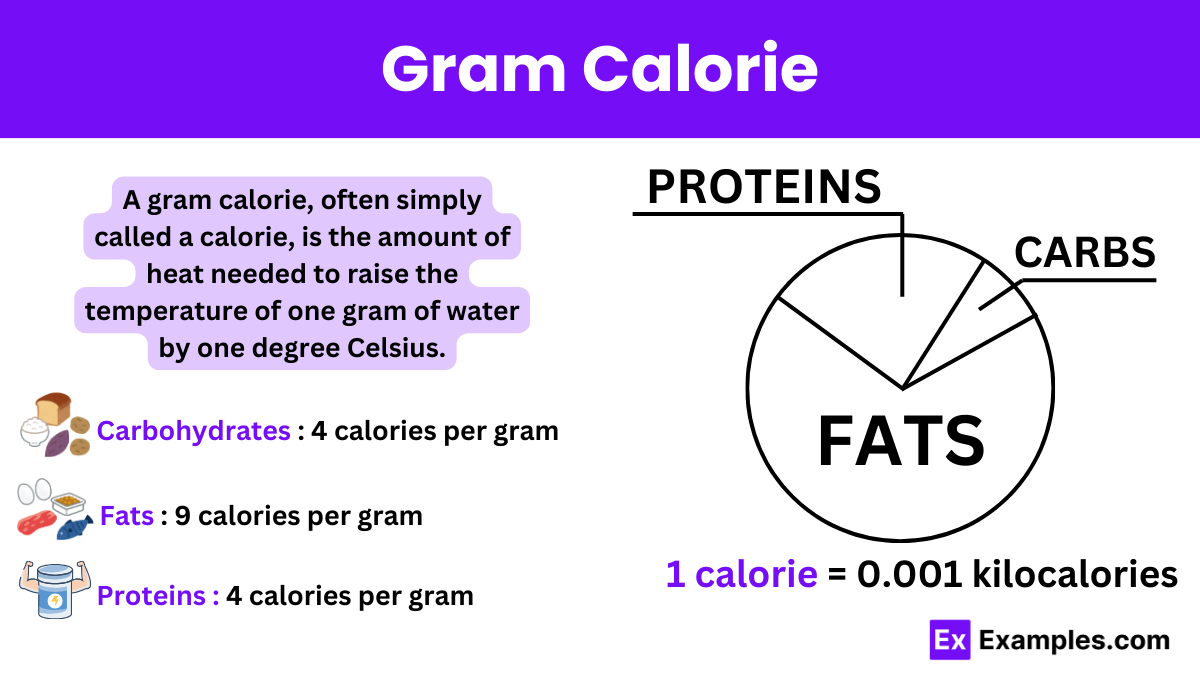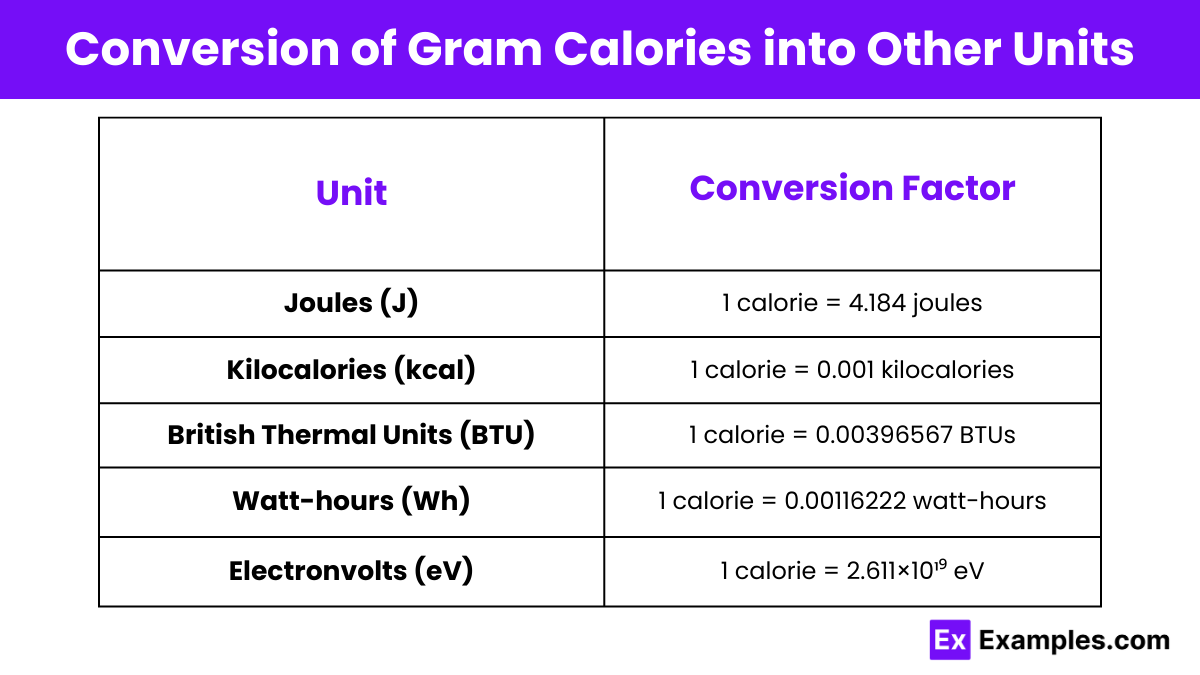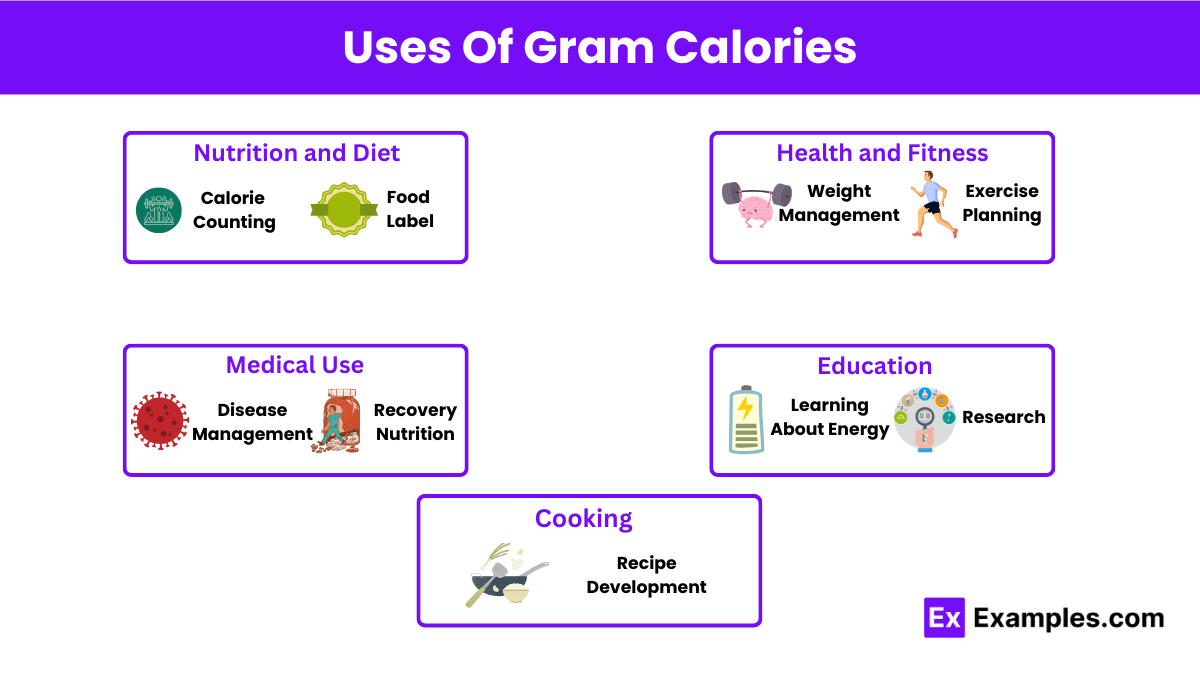What is a gram calorie (cal)?
A unit of weight
A unit of length
A unit of energy
A unit of temperature


A gram calorie, typically just referred to as a calorie, is a small unit of energy that quantifies the amount of heat required to raise the temperature of one gram of water by one degree Celsius at a standard pressure. This unit is fundamental in scientific studies involving energy and heat, particularly in fields such as chemistry and physics.
In the realm of nutrition, when people refer to calories in food, they are usually talking about kilocalories (kcal), which are 1000 times larger than gram calories. Each kilocalorie is equivalent to 1000 gram calories. Therefore, when a food package states that it contains 200 calories, it actually means it contains 200 kilocalories, or 200,000 gram calories.

Converting gram calories into other energy units is a fundamental process in various scientific, nutritional, and engineering fields. Here’s a detailed look at the main ways to perform these conversions, particularly focusing on converting calories to joules (the standard SI unit of energy) and kilocalories (commonly used in nutritional contexts).
| Unit | Conversion Factor |
|---|---|
| Joules (J) | 1 calorie = 4.184 joules |
| Kilocalories (kcal) | 1 calorie = 0.001 kilocalories |
| British Thermal Units (BTU) | 1 calorie = 0.00396567 BTUs |
| Watt-hours (Wh) | 1 calorie = 0.00116222 watt-hours |
| Electronvolts (eV) | 1 calorie = 2.611×10¹⁹ eV |
Joules are the standard unit of energy in the International System of Units (SI). The conversion from calories to joules is based on the precise energy equivalence established through experimental measurements.
While the term “calorie” is commonly used in nutritional contexts, it technically refers to kilocalories in food labeling and diet discussions.
British Thermal Units (BTUs) are a unit of heat commonly used in the United States, especially in heating and air conditioning systems. One BTU is defined as the amount of heat required to raise the temperature of one pound of water by one degree Fahrenheit.
Watt-hours, a unit of energy typically used to measure electrical energy, can also be related to calories.
Electronvolts (eV) are a unit of energy commonly used in the fields of physics and chemistry, particularly when discussing atomic, nuclear, and particle physics. An electronvolt is defined as the amount of kinetic energy gained or lost by a single electron as it moves across an electric potential difference of one volt.
To convert calories to electronvolts, use the conversion factor where 1 calorie equals approximately 2.611×1019 electronvolts.
Example: To convert 100 calories to electronvolts:
Understanding gram calories in macro nutrients involves knowing the energy provided by carbohydrates, proteins, fats, and alcohol per gram. This knowledge is crucial for nutritional planning, calculating dietary energy intake, and managing health and wellness through diet.
When converting grams to calories, it’s important to recognize that the caloric content varies depending on the type of macro nutrient being measured. Each macro nutrient—carbohydrates, proteins, fats, and alcohol—provides a different amount of energy per gram. Below is a detailed conversion table that outlines the caloric value for each macro nutrient, facilitating accurate dietary calculations and nutritional assessments.
| Macronutrient | Calories per Gram | Description |
|---|---|---|
| Carbohydrates | 4 calories per gram | Carbohydrates are the body’s primary source of energy and are quickly metabolized into glucose. |
| Proteins | 4 calories per gram | Proteins are essential for body repair, growth, and as an energy source when needed. |
| Fats | 9 calories per gram | Fats provide a concentrated source of energy and are essential for nutrient absorption and insulation. |
| Alcohol | 7 calories per gram | Although not a nutrient, alcohol provides significant calories without nutritional benefits. |

Gram calories are a measure of energy commonly used in nutrition to indicate how much energy food will provide your body when eaten. This measure is crucial for various practical and educational purposes, as explained below:
The caloric content of 1 gram depends on the macro nutrient it represents. Specifically:
Therefore, the number of calories in 1 gram varies depending on the specific macro nutrient.
The number of calories in a gram of food varies depending on the specific food item. Therefore, it’s essential to refer to the nutritional information provided on the packaging or use a food database to determine the caloric content of one gram of the food in question.
To determine the number of grams in 200 calories of a specific food, you’ll need to know the caloric density of that food. The caloric density is typically provided on the packaging or can be found in a food database. Once you have the caloric density, you can use the formula:
For example, if the caloric density of a food is 4 calories per gram, then:
Grams=200 calories/4 cal/g=50 grams
Therefore, 200 calories would be equivalent to 50 grams of that particular food.
Text prompt
Add Tone
10 Examples of Public speaking
20 Examples of Gas lighting
What is a gram calorie (cal)?
A unit of weight
A unit of length
A unit of energy
A unit of temperature
How many gram calories are needed to raise the temperature of 2 grams of water by 1 degree Celsius?
1 cal
2 cal
3 cal
4 cal
What is the symbol for gram calorie?
J
cal
kcal
W
How many joules are in 1 gram calorie?
0.418 J
4.184 J
41.84 J
418.4 J
Which is larger, a gram calorie or a kilocalorie?
Gram calorie
Kilocalorie
They are the same
It depends on the context
How many gram calories are in 1 kilocalorie?
10 cal
100 cal
1000 cal
10000 cal
If you consume 500 calories from food, how many kilocalories is this?
0.5 kcal
5 kcal
50 kcal
500 kcal
How much energy in calories is required to raise the temperature of 10 grams of water by 2 degrees Celsius?
10 cal
20 cal
30 cal
40 cal
How many calories are required to raise the temperature of 50 grams of water by 1 degree Celsius?
5 cal
10 cal
50 cal
100 cal
If a food item contains 150 kcal, how many gram calories does it contain?
150 cal
1,500 cal
15,000 cal
150,000 cal
Before you leave, take our quick quiz to enhance your learning!

